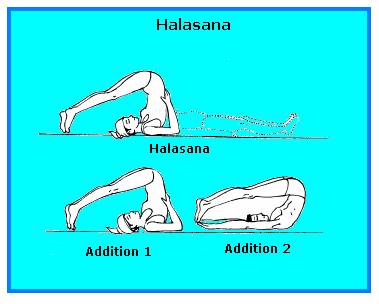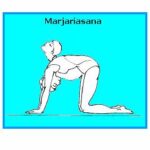Halasana
Exercise-113: Halasana (The plough pose)
- Lie flat on the back with the arms straight and beside the body, palms facing downward.
- Keeping the legs straight, slowly raise them to the vertical position above the body.
- Only use the stomach muscles to raise the legs. Do not use the arms.
Simultaneously bend the trunk upward, hips first. - Slowly lower the legs over the head and touch the floor with the toes of both feet.
- Keep the legs straight, bend the arms and place the hands on the back as in sarvangasana.
- Relax the body.
- Remain in the final pose for a comfortable period of time.
- Then either return to the starting position or perform the following additions to the basic pose:
Additions-
- Move the feet away from the head until the body is completely stretched and a tight chin lock occurs.
- Move the feet towards the head until the back is fully tensed. Keep the legs straight and directly above the head. Grasp the feet with the fingers.
Maintain these poses for a comfortable length of time, then return to the final pose of basic halasana.
Breathing-
- Retain inside while assuming and returning from the pose.
- Breathe slowly and deeply in the final pose.
Duration-
- Adepts can hold the final pose of halasana and the two additional stages for more than 10 minutes each.
- Beginners should hold each pose for 15 seconds during the first week of practice, doing each in rotation up to 4 times and adding 15 seconds every week until each pose is held for 1 minute.
Concentration-
On the abdomen, relaxation of the back muscles, respiration or the thyroid gland.
Sequence-
- If possible perform halasana immediately after sarvangasana.
- Follow halasana by matsyasana, ushtrasana or supta vajrasana, practiced for half of the combined duration of sarvangasana and halasana.
Precautions-
Beginners should not do poorwa halasana until their back muscles become flexible.
Limitations-
Not for old and infirm people, sufferers of sciatica and other back ailments, or high blood pressure.
Benefits-
- Adjusts the functioning of the abdominal organs, especially the kidneys, liver and pancreas.
- Activates digestion, relieves constipation and removes fat from the waist.
- Beneficially influences all the visceral organs.
- Regulates the activities of the thyroid, thereby balancing all the body’s metabolic rates.
- Helps to remedy diabetes, eliminate piles, loosen the vertebrae and tone the spinal nerves.
GO BACK



Facebook Comments